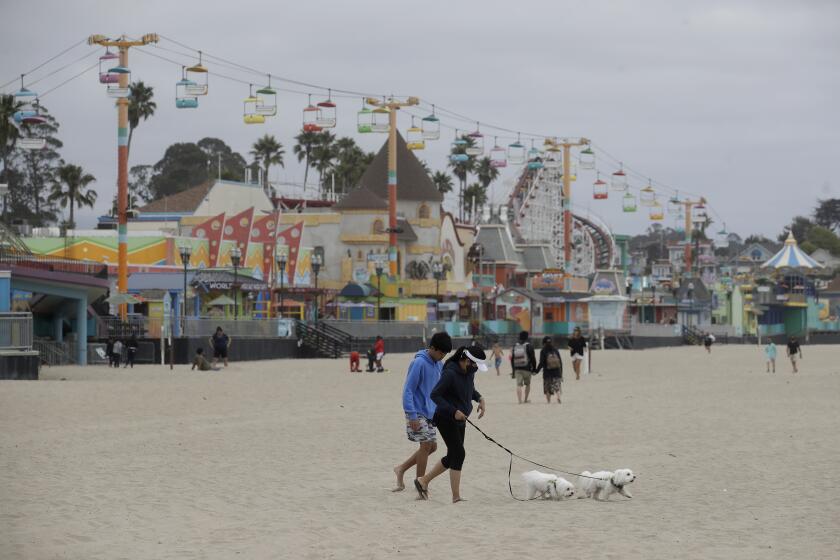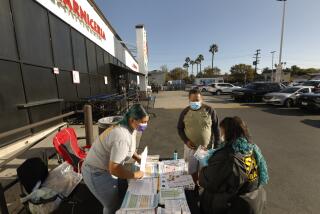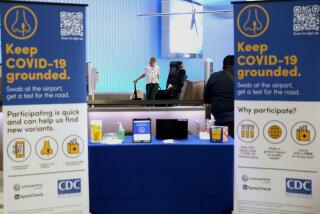L.A. County finally seeing declines in Latino, Black coronavirus mortality rates

- Share via
Los Angeles County health officials Wednesday reported some promising metrics in the fight against the novel coronavirus, including an overall decline in death rates across all demographics and a “narrowing of the gap” among victims of varying racial, ethnic and socioeconomic backgrounds.
Black and Latino residents and those living in lower-income neighborhoods have been among those hit hardest by the virus in Los Angeles County, Public Health Director Barbara Ferrer said.
Officials say that’s largely due to the initial limited access to testing among those communities at the beginning of the pandemic and the fact that many residents work in essential and high-risk settings, many of whom lacked proper protective equipment, such as masks, before such gear was required.
The expansion of countywide testing and protective equipment now being mandated in workplaces has helped remedy both problems, contributing to a drop in the number of overall deaths in the county, officials said.
“Not only are we seeing decreases, but we’re seeing a narrowing of the gap,” Ferrer said of the number of deaths in the county.
Although Los Angeles County has met most of the state’s benchmarks to allow further reopenings, the average number of infections is still too high.
During the peak of transmission in July, Black residents “had a rate at four deaths per 100,000 people,” the county said in a statement. That rate was three times that of white residents during the same time period. The mortality rate for Black residents is now 1.7 deaths per 100,000 people, which is slightly higher than that of white residents.
Latinos have seen deaths per 100,000 people decline from a high of six in July to 2.4. “While decreasing, this is still 2.5 times higher than white residents,” the county said in a statement.
L.A. County health officials reported 61 new coronavirus-related fatalities Wednesday, pushing the overall death toll to nearly 5,400. On Tuesday, the county reported 64 deaths. And Ferrer said earlier this week that the seven-day daily average number of deaths has fallen from 43 in mid-July to 30 in mid-August.
Also Wednesday, there were 1,956 new cases recorded, including 100 from the state’s backlog — which stemmed from a breakdown in the electronic collection of test data more than two weeks ago — and a few hundred from laboratories that had delayed reporting Tuesday.
Still, officials emphasized the need to remain vigilant.
“We can’t let that progress allow us to become complacent,” state Health Services Director Dr. Christina Ghaly said.
There are now more than 225,000 confirmed cases of COVID-19 in the county, including about 2,400 positive test results from a backlog spanning the last week of July until nine days ago; Ferrer thinks at last 2,000 cases are still missing. The seven-day average for positive infection is now just below 6%, which is below the state’s safety threshold of 8%. For months, the county had exceeded that rate.
Officials also reported that 1,378 people are hospitalized in the county, continuing a downward trend over the last 2 1/2 weeks.
But a handful of counties across the state are seeing an uptick in the number of people hospitalized, a potential sign of a surge in transmission rates.
California has recorded a 17% decrease in hospitalizations over a 14-day period, Gov. Gavin Newsom said Wednesday during a news briefing. But the decline has not been steep and recent numbers are somewhat troubling, he said.
“The last few days is an important point of caution and consideration as it relates to our efforts,” Newsom said, noting that Wednesday’s hospitalization rate dipped just 0.1% from the day before.
Among the state’s hospitalized patients, 19% are in intensive care, down from 23% reported roughly two weeks ago.
At least five counties — Alameda, Monterey, San Luis Obispo, San Mateo and Sonoma — have seen increases in hospitalizations above the state’s safety threshold for at least three days, according to the California Department of Public Health’s watchlist.
Nearly a dozen other counties, including Orange, Ventura and San Francisco, reported slight increases Tuesday in hospitalized patient counts, but those numbers were far below the state’s compliance level of a 10% increase or lower.
The rate of community transmission of the illness is especially concerning as the state battles multiple major fires, forcing tens of thousands of residents to evacuate, and an extreme heat wave that has prompted blackouts and repeated calls for energy conservation.
“We have challenges — not only with energy challenges as it relates to conditions with wildfires, but we also continue to be challenged by this pandemic,” Newsom said Wednesday.
Because the virus is a respiratory infection, there is some concern that extreme heat and smoke from the fires could exasperate symptoms of those infected. Ferrer advised anyone having breathing problems to contact a health provider or to call dial 911 if in dire need.
“This should not be a time for people that are already sick to play around with their own health when they are struggling to breath,” she said.
More to Read
Sign up for Essential California
The most important California stories and recommendations in your inbox every morning.
You may occasionally receive promotional content from the Los Angeles Times.












